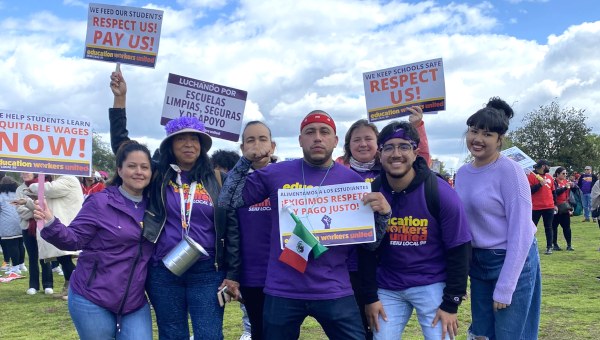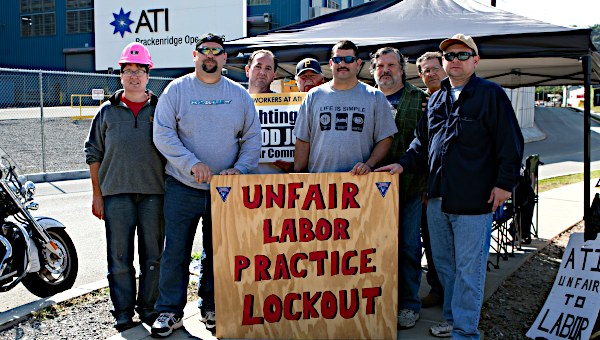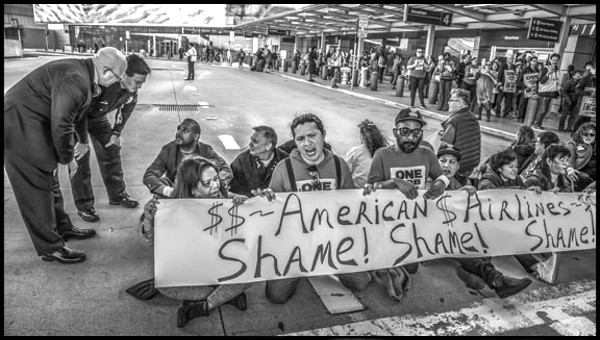Standing Up to Indiana’s Attack on Unions
Some 10,000 angry workers swarmed around the Indiana State House January 23 to protest a pending anti-union ‘right-to-work’ bill that the Republican-controlled state Senate passed by a vote of 28-22. The next day, another 7,000 workers returned, enraged by the Senate vote. The crowd was broad and diverse, including members of the Ohio AFL-CIO who came by bus from Columbus to join the fight. The crowd carried signs like “Indiana-Ohio-Wisconsin,” which linked the struggle against Indiana’s right-to-work legislation to the successful union-led campaign to overturn anti-labour legislation in Ohio and the effort to recall Wisconsin Governor Scott Walker.

The bill now must pass the Indiana House of Representatives before it is presented to the governor to be signed into law. But workers, Occupy activists and other allies are gearing up for a mass march on January 28 to send a message that Indiana workers won’t take union-busting lying down.
On Tuesday, a huge contingent of workers gathered outside the chambers of the Indiana House, which was in session, chanting “Whose House? Our House!” and “The workers united will never be defeated!” They also yelled, “Let the people vote!” in reference to an attempt, blocked by Republicans, to put the right-to-work law on the November ballot.
NFL Players and Super Bowl
Workers also chanted “Occupy the Super Bowl,” no doubt sending a collective shiver down the spines of NFL executives swarming Indianapolis in preparation for the big game scheduled for Sunday, February 5, at Lucas Oil Stadium.
Union workers have been working around the clock on various construction projects to beautify the city prior to the event. The NFL Players Union issued a strong statement condemning the anti-worker bill, and if this bill passes this week, it will show the lawmakers’ contempt for the labour of these workers and the spirit of solidarity shown by the Players Union.
Tuesday concluded with House Democrats refusing to return for the afternoon’s legislative session, a tactic they have used repeatedly since 2011 in order to forestall passage of right to work. Just like last year, when Senate Democrats walked out and refused to participate in the discussion, the crowd in the State House exploded in cheers.
Unions and progressive groups have rightly dubbed the proposed legislation ‘the right-to-work-for-less’ bill. The bill, which allows workers to “opt out” of paying their fair share of union dues, is a naked bid to reduce the power of unions in the workplace and give bosses greater power to intimidate or misinform workers about joining unions. The bill is legalized union-busting at its worst.
The corporations and industry groups behind the bill are not shy about the reasons for their support. “Companies [are] attracted to right-to-work states not because of lower wages but because [of] the weakened role of unions…which lowers their costs,” John Sampson, president of the Northeast Indiana Regional Partnership, a prominent business group, told the New York Times.
Occupy and Unions Fight Right-to-Work Bill
‘The-right-to-work-for-less’ law is opposed by a majority of ordinary people in Indiana. Two-thirds are against passage of the bill, and 69 per cent reject Republican plans to pass it this week. It is a stark testimony to the undemocratic nature of legislative politics that Indiana senators, soaked in corporate money, passed this bill while more than 10,000 workers aired their rage outside the legislature’s closed doors.
But a winning strategy to defeat the bill will have to go beyond the floor of the Senate; the struggle will have to be won on the streets. The real strength of the labour movement lies in mobilizing the power of workers, not in politicking by ‘progressive’ legislators whose support is partial and unreliable.
The Indiana AFL-CIO’s role in the battle against this bill has been hesitant at best, insisting that this fight must be won “inside the legislature.” But as Tuesday’s events showed, the Democrats’ presence during the vote – and their obvious efforts to make deals with individual Republican senators to win a vote or two – did not stop the Republicans from ramming this bill through.
In truth, the AFL-CIO can and should go beyond the tepid tactics offered by Democratic Party leaders. The size of this week’s mobilizations clearly demonstrates that rank-and-file union members (and even some individual union officials) are prepared to fight.
And now, those in the labour movement prepared to struggle with new energy are teaming up with the most natural ally for organized labour to emerge in recent times: the Occupy movement.
When members of Occupy Purdue met with local labour unions in the Lafayette/West Lafayette area to build a movement against the right-to-work bill, both sides surprised each other by how much they already had in common. From rejection of corporate power to recognizing the power of organized labour – the two groups had a lot to talk about.
The Occupy groups, in conjunction with the electricians and builders unions, decided to call for a rally at the State House on January 28, the eve of Super Bowl week. The eyes of the world will be on Indianapolis because of the Super Bowl, and it will be an important time to draw attention to the draconian nature of the right-to-work bill.
Once the call went out for the rally, endorsements began to flood in. Currently, the rally has been endorsed by Indiana’s Northwest Central Labor Council, the Lafayette Teachers Union, Communication Workers Local 4730 at Indiana University, Occupy Purdue, Occupy Terre Haute and Occupy Lafayette. The sheet metal workers union and the International Brotherhood of Electrical Workers Local 668 are providing buses to transport Occupy activists and union members to the rally. The United Transport Workers has also made material contributions.
Coming Days
In the coming days, it will be important to continue to build this fight in the streets. If we are to push the politicians into putting the right-to-work law on an upcoming ballot, then we need collective solidarity actions up and down the state, not just letter writing and call-in campaigns to representatives. Occupy activists in every town need to reach out to their local unions in order to plan and build actions, and unions need to encourage and support the Occupy activists.
The 1 per cent builds partnerships with corporations and political thugs to break our movements. As the 99 per cent, we need to build our own solidarities. A strong alliance between organized labour and the Occupy movement is needed to stand up to this attack on workers’ rights. •
This article first appeared on the Socialist Worker website.





